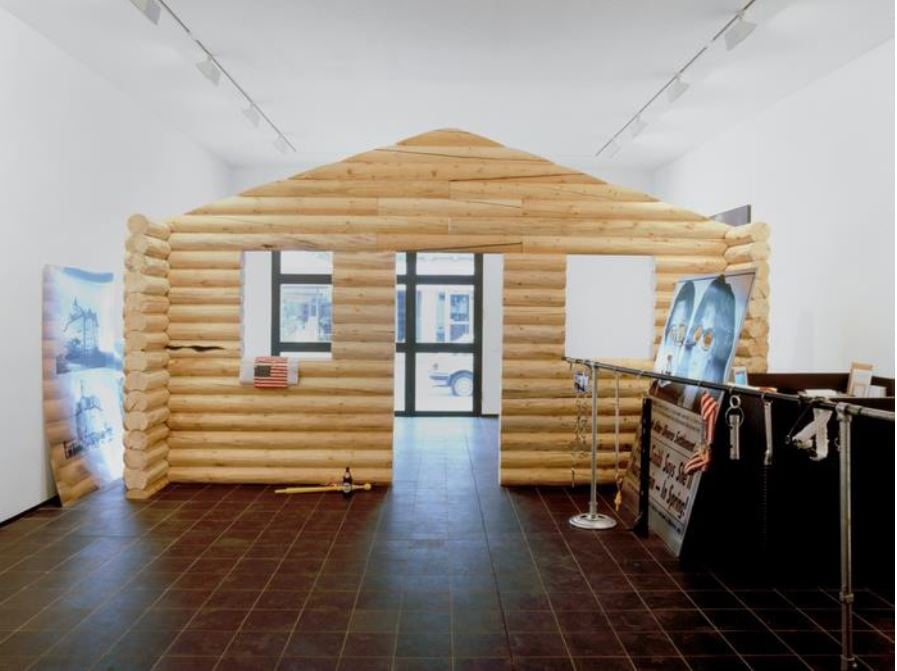Art World
Art Dealers Strike Back at Artist Cady Noland in an Increasingly Philosophical Legal Dispute About a Restored Sculpture
The lawsuit over Noland's restored Log Cabin sculpture is picking up steam.

The lawsuit over Noland's restored Log Cabin sculpture is picking up steam.

Julia Halperin

Can a work of art be original, extremely valuable, and art historically significant—but still be impossible to copyright?
A group of art dealers and a private collector are making this very argument in an ongoing legal battle with the artist Cady Noland. The case raises questions about what makes a work of art unique, what a collector is or isn’t allowed to do with art he owns, and at what point conservation becomes tantamount to creating an entirely new object.
In July, Noland—one of the most elusive and sought-after American artists working today—filed a lawsuit claiming that a collector and a trio of dealers had violated her copyright by hiring a conservator to repair her sculpture Log Cabin (1990) without consulting her. The repair, Noland says, went way beyond the bounds of normal conservation.
Noland sued the collector Wilhelm Schurmann, who bought Log Cabin soon after it was made; KOW Gallery of Berlin, which displayed the work in a 2011 exhibition; Galerie Michael Janssen and Janssen himself, who sold Log Cabin to an Ohio collector in 2014 for $1.4 million; and art advisor and dealer Chris D’Amelio. Noland says that some, if not all, members of this group were involved in the decision to refabricate the work after the original wood began to rot in 2010.
Now, the dealers and collector are fighting back. In a motion to dismiss the case filed last month, they describe Noland’s suit as “a desperate but futile search for a cause of action, by an artist with a history of trying to keep artworks created by her from being sold.”
No one involved in the case disputes that Log Cabin—which comprises the façade of a standard cabin produced by a commercial manufacturer and two American flags hanging from the windows—is art. But the defendants say that the artistry of the work lies in the idea behind it, not the physical expression of the logs piled on top of one another. In fact, they contend, the actual construction of the work is so generic that Log Cabin is impossible to copyright.
“Were placing two American flags on a traditional log cabin façade enough to warrant copyright protection, then any log cabin owner who affixes a similar patriotic symbol to the front of their home might be considered an infringer via the creation of an unauthorized derivative work,” the collector and galleries’ lawyer writes.
And, if the object itself can’t be copyrighted, they argue, then they cannot be held liable for any copyright infringement.
If the case makes it to trial, a judge will have to consider the slippery nature of Noland’s art—the very quality that makes her influential to a younger generation of artists. She often uses outside fabricators and existing objects to create works that embody the darker side of America. Log Cabin, like much of her work, is neither a straightforward Duchampian readymade nor a traditional, made-in-the-studio sculpture.
“We don’t dispute the merit or art historical importance of Cady Noland’s body of work or artistic practices,” the lawyer Megan Noh of the firm Cahill, Cossu, Noh, & Robinson, who is representing most of the defendants, told artnet News. “But there is not necessarily a correlation between artistic or monetary value and copyrightability. In fact, copyrightability may not even be a particularly relevant metric for the evaluation of a work’s contribution to the discourse, given that the copyright criteria do not take into account a work’s creative intent or intended meaning…. Although Ms. Noland’s claims must also fail for other substantive reasons, the complaint is a house of cards that falls apart on a finding of un-copyrightability.”
So far, at least one US government agency is siding with the dealers. The US Copyright Office has repeatedly rejected Noland’s application to register Log Cabin as a work of art “because the work lacked the minimal degree of creativity to qualify for registration,” Noland’s lawyer explained in a brief filed earlier this week. Specifically, the Copyright Office had conveyed to Noland’s team that the work’s construction “is exactly what one would expect to see in a ‘classic’ log cabin design”—and that its outward appearance would be “inevitable” in any such design. (Noland has filed another appeal with the office, which is currently pending.)
The artist, obviously, feels differently. “Clearly, the Copyright Office does not understand contemporary art,” her lawyer wrote earlier this week. Log Cabin, he said, was the result of a series of intentional creative decisions. “Noland was not designing backyard garden sheds and trying to seek copyright protection for her design. Instead, she made a sculpture that was neither a house, garden shed, or a shelter, and strategically draped her signature American flags over one of the ‘window’ openings.”
Noland’s lawyer, Andrew Epstein, did not respond to artnet News’s request for comment by press time. In a separate motion, Chris D’Amelio’s lawyer argued that Noland’s complaint “fails to allege a single act that D’Amelio, specifically, took.”
Noland—who almost never gives interviews, hasn’t shown new work since 2000, and has a history of disowning art—provided a rare statement in an affidavit submitted to the judge this week. “I do not think I am difficult to work with,” she said. She noted that she has personally restored several works over the past year so that they could be sold. “I just do not want anyone to change, modify, or destroy my art,” she said.